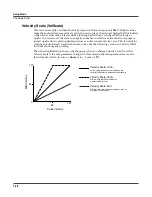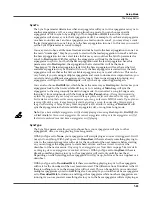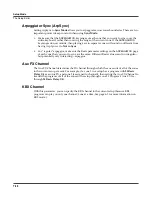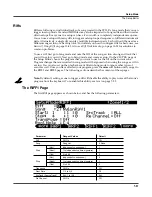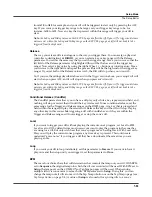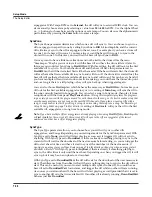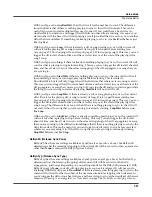
7-42
Setup Mode
The Setup Editor
pattern steps, use the alpha wheel, alphanumeric pad, or plus/minus buttons to enter the note
shift amount for each step. Press
More
to
see a second page for patterns with more than 24 steps.
You can insert a step with a value of “none” by entering -127 and then shifting down one more
step. A step with the value “none” causes the arpeggiator to play nothing for that step, allowing
you to create rhythmic patterns by using “none” to leave spaces. When the arpeggiator
determines the range of pattern notes played with the
Limit
parameter (see below,) steps with a
value of “none” will be calculated as a step value of 0.
Use the
chan up/down
buttons to change the direction in which pattern steps are played
(indicated by
Up
,
Down
, or
Flat
on the right of the top line.) With pattern direction set to
Up
, the
pattern plays as expected, starting at step one and moving up through each step towards step
48. With pattern direction set to
Down
, the pattern starts at step one, but then moves to the last
step and continues to move backwards through the steps down towards step 1. Additionally,
patterns set to
Down
base all notes after step one in the octave below the first note played. These
settings are most useful for arpeggiating chord patterns upwards or downwards from the root
note. Patterns set to
Flat
will not repeat in other octaves like those set to
Up
or
Down
(depending on the
Limit
parameter.) Patterns set to
Flat
play without transposition, the
Limit
parameter will not transpose the pattern but it can still restrict note range.
Press
Delete
to delete the pattern from memory. Press
Rename
to rename the pattern and save.
Pressing
Save
gives you the option to save the pattern or rename and save. To create a new
ShiftPatt, edit an existing pattern and choose Rename when saving. Press Exit to return to the
ARPEGGIATOR page. When exiting the editor, it will automatically give you the option to save
the pattern if changes have been made. For more detailed instructions on these functions, see
Saving and Naming
on page 5-3.
Содержание PC3LE6
Страница 10: ...vi...
Страница 24: ...2 10 Startup Software Upgrades...
Страница 38: ...3 14 User Interface Basics Quick Song Recording and Playback...
Страница 42: ...4 4 The Operating Modes Using the Modes...
Страница 64: ...6 16 Program Mode The Program Editor...
Страница 134: ...7 70 Setup Mode The Control Setup...
Страница 138: ...8 4 Quick Access Mode The QA Editor...
Страница 194: ...10 34 Song Mode and the Song Editor Song Editor The EVENT Page...

